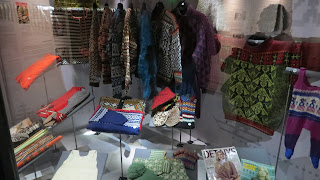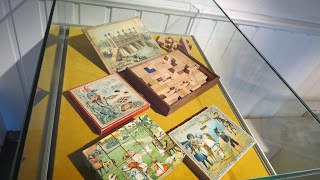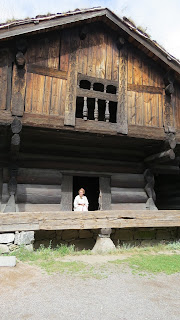Norsk Folkemuseum at Bygdoy,Oslo, is a museum of cultural history with extensive collections of artifacts from all social groups and all regions of the country, especially the Sami culture was so interesting for me.
The
museum section has detailed information, the Sami culture exhibitions were so interesting.
Rein deers have a special importance in their life, every part of the reindeers was used, as said so.
If you are a craft, embroidery, vintage items lover like me this museum's exhibitions will be great for you.
All these hand-made trims, accessories looks amazing, their bright colors shows the quality of material they have used.
What I've read in the museum displays about the changing parameters, during the course of the 1800’s,
radical changes in social structure reduced the possibility of maintaining a
living folk art tradition. By the end of the century there was no longer a
basis for producing specifically rural crafts. The growth of industry made the
products of rural craftsmen superfluous. Old lines of tradition in crafts died
out as most of the other countries.
But while folk art was in the process of going out of
fashion in its original environment, it became the object of increasing
attention from city dwellers. The many and varied forms of expression in folk
art, using different materials and
decorative techniques, changed and declined throughout an extended period of
time. In a few places, the folk art tradition remained alive until the 1900’s.
In the spirit of national romanticism, folk art was held up
as an example to home crafts and applied arts producers as a counterweight to
industrially produced goods. Soon copies of folk art products were being made
to suit the taste of middle class city dwellers. At the same time some artists
began using folk art as an inspiration of their new works. But in rural areas
popular creativity developed in other directions.
There is a special section in the museum for those fantastic Norway sweaters that I loved. To learn how Marius sweaters and Sandnes designs were created by Unn Soiland was so interesting.
All those details of the most popular knit style must be the Marius series among the others. Norwegian Ladies must be so patient to create all those wonderful sweaters, accessories using all those complex patterns.
I wonder who was the owner of this paper baby-doll.
As I've told several times before, Norwegians pay a special attention to create museums. They give a special attention for the visual education of kids....According to my observations, local people come to museums with their children, museums have a special place in their education system.
Toys made for children often mirror the adult world
in the form of miniatures and down scaled tools and utensils, thus creating
clear categories of toys for boys and girls.
It is so impressive that young generation takes a role to bring their all known traditions today.
An old home from 1800's. . Hosts walk around in old Norwegian clothes and make the place come to life!
I loved all those accessories, this young lady told that all of them original pieces and that red trim is totally handmade piece.
At various spots there are
young people dressed in original costumes that help you understand how they
lived
You feel like you're in a real
Viking age village, with even roaming animals, some ladies were cooking in
their routine life in those days, etc..
The Stave Church from 1200 is especially
worth seeing.
It's
a nice walk in the open park
museum, you see a lot of old Norwegian
houses and farms showing life in the starting from 16th centuries till present
time in Norway.
It's a nice walk through
the woods while you see a lot of old Norwegian houses, barns and farms.
The reproductions are precisely selective and you feel like you're in a real Viking age village, with even roaming animals!!!
This is a real large area with
many buildings showing life in the 18th and 19th century in Norway.

















2 comments:
I love museums so this would be a place I know I'd enjoy, especially seeing the amazingly knitted sweaters.
It was so interesting section, I never expected it there...
Post a Comment